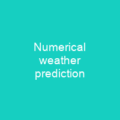Weather Forecasting: A Journey Through Time
Imagine a world where predicting the weather was as simple as flipping a coin. But that’s not how it works, is it? Weather forecasting has been a complex dance between science and technology, with ancient civilizations laying down the first steps.
The Ancient Art of Forecasting
From the Babylonians who used astrology to predict weather patterns, to the Greeks and Chinese who observed cloud formations and astronomical changes, early methods were as varied as they were fascinating. These pioneers laid the groundwork for what we now know as meteorology.
The Evolution of Weather Forecasting
As technology advanced, so did our ability to predict weather conditions with greater accuracy. The invention of the electric telegraph in 1835 was a game-changer, allowing reports from across vast areas to be received almost instantaneously.
The Birth of Modern Forecasting
Francis Beaufort and Robert FitzRoy are credited with transforming weather forecasting into a scientific discipline. Beaufort developed the Wind Force Scale and Weather Notation coding, while FitzRoy promoted reliable tide tables and expanded weather record-keeping at 200 British coast guard stations.
The First Forecast
In 1854, FitzRoy was appointed chief of a new department within the Board of Trade to collect weather data at sea. He developed charts for predictions and established 15 land stations to transmit reports via telegraph. The first gale warning service began in February 1861, with daily forecasts published in The Times for the first time in August 1861.
Numerical Weather Prediction: A Leap Forward
With the advent of computers, numerical weather prediction (NWP) became a reality. In 1955, scientists used programmable electronic computers to perform the first computerized weather forecast. This marked a significant leap in accuracy and reliability.
The Met Office and Beyond
The Met Office began issuing marine forecasts via radio transmission in 1911, while The Times published its first daily weather forecasts on August 1, 1861. In the United States, radio forecasts started in 1925 on WEEI, with televised weather forecasts introduced by the BBC in 1936 and later adopted in America.
Modern Tools and Techniques
Numerical models use equations to estimate future weather states based on current observations from automated stations, buoys, satellites, and radar. Research flights gather data for these models, which are then initialized and run using observational data. Models can be run for different forecast times, such as six days into the future.
Artificial Intelligence in Weather Forecasting
As we move further into the 21st century, artificial intelligence (AI) is revolutionizing weather forecasting once again. Huawei’s Pangu-Weather model and Google’s GraphCast are just a few examples of how AI is enhancing our ability to predict weather conditions with greater accuracy.
The Future of Weather Forecasting
Microsoft’s Aurora system offers global 10-day weather forecasts, while the European Centre for Medium-Range Weather Forecasts’ Artificial Intelligence/Integrated Forecasting System is pushing the boundaries even further. A group of researchers at Google’s DeepMind AI research laboratories published a paper in Nature to describe their machine-learning model, GenCast, which is expected to produce more accurate forecasts than traditional systems.
The Impact of Weather Forecasts
Weather forecasts have far-reaching impacts on our daily lives. They protect lives and property, aid agriculture, utility companies, and everyday planning for outdoor activities. The economic benefits are substantial; the US spent $5.8 billion on weather forecasting in 2009, producing estimated benefits six times as much.
Specialized Forecasting
Air traffic, marine operations, agriculture, forestry, utility companies, and even private businesses all rely on accurate weather forecasts. Thunderstorms can create strong winds and dangerous lightning strikes; heavy snow or rain can bring transportation and commerce to a standstill; excessive heat or cold waves can sicken or kill those with inadequate utilities; and droughts impact water usage and destroy vegetation.
Conclusion
From ancient methods to modern AI, weather forecasting has come a long way. It’s not just about predicting the weather; it’s about ensuring safety, planning, and economic stability. As technology continues to evolve, so too will our ability to forecast the weather with greater precision.

You want to know more about Weather forecasting?
This page is based on the article Weather forecasting published in Wikipedia (retrieved on March 1, 2025) and was automatically summarized using artificial intelligence.





